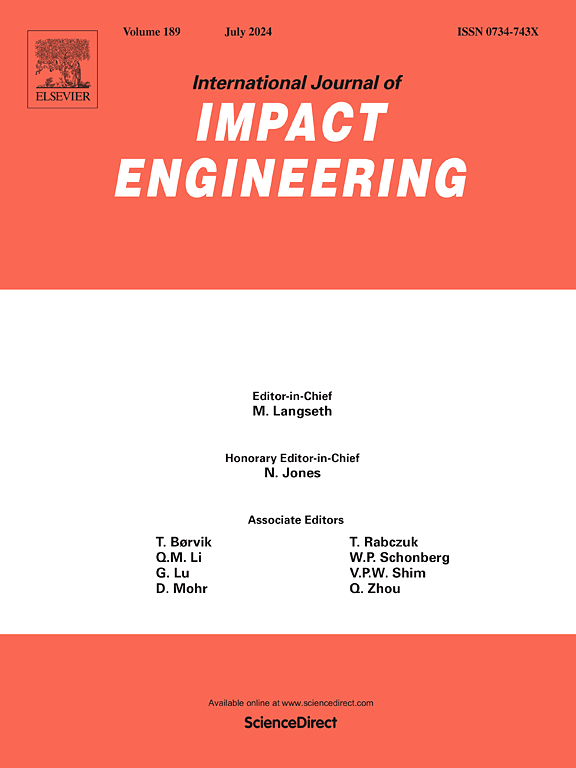小行星偏转:分裂撞击器的多次撞击会增加总动量转移吗?
IF 5.1
2区 工程技术
Q1 ENGINEERING, MECHANICAL
International Journal of Impact Engineering
Pub Date : 2025-04-23
DOI:10.1016/j.ijimpeng.2025.105363
引用次数: 0
摘要
小行星撞击对地球构成重大威胁,使行星防御战略至关重要。其中,动能撞击已成为一种很有前途的小行星偏转方法。本研究探讨了如何在固定载荷预算质量为m的情况下最大限度地将动量转移到小行星上。研究了两种撞击配置:(i)在同一位置使用不同的目标和速度进行三到四次重复撞击,以及(ii)同时使用两个撞击器撞击岩石目标,每个撞击器的总质量(m/2)为一半。目的是确定这些构型的总动量增强因子β是否超过单个未分裂的撞击器。在构型(i)中,β通常随着每次连续撞击而减小。有趣的是,β并不总是与陨石坑效率相匹配;虽然产生了较大的抛射物质量,但其较低的速度有时会减少总的动量传递。CTH冲击物理模拟显示,先前存在的陨石坑几何形状导致了β的下降。在构型(ii)中,同时冲击产生的β值低于单个未分裂冲击器。令人惊讶的是,两次同时撞击产生的β与单个半质量(m/2)撞击产生的β相似,即使在某些附近的撞击效率更高。这些结果表明,在所研究的条件下,劈裂撞击器不会增加动量增强。总体而言,撞击效率与β之间的关系呈现非线性,并且高度依赖于特定的撞击构型。本文章由计算机程序翻译,如有差异,请以英文原文为准。
Asteroid deflection: Do multiple impacts from a split-impactor increase total momentum transfer?
Asteroid impacts pose a significant threat to Earth, making planetary defense strategies vital. Among these, kinetic impact has emerged as a promising method for asteroid deflection. This study investigates how to maximize momentum transfer to an asteroid within a fixed payload budget of mass . Two impact configurations were examined: (i) three to four repeated impacts at the same location using varied targets and velocities, and (ii) simultaneous impacts with two impactors, each with half the total mass (), delivered at different proximities on rock targets. The goal was to determine if the total momentum enhancement factor, , in these configurations exceeds that of a single, unsplit impactor. In configuration (i), generally decreased with each successive impact. Interestingly, did not always scale with cratering efficiency; although larger ejecta mass was produced, its lower velocity sometimes reduced the overall momentum transfer. CTH shock physics simulations revealed that pre-existing crater geometry contributed to the decrease in . In configuration (ii), the simultaneous impacts yielded a value lower than that of the single unsplit impactor. Surprisingly, from two simultaneous impacts was similar to that of a single half-mass () impactor, even with higher cratering efficiency at certain proximities. These results indicate that splitting the impactor does not increase momentum enhancement for the investigated conditions. Overall, the relationship between cratering efficiency and appears nonlinear and highly dependent on the specific impact configuration.
求助全文
通过发布文献求助,成功后即可免费获取论文全文。
去求助
来源期刊

International Journal of Impact Engineering
工程技术-工程:机械
CiteScore
8.70
自引率
13.70%
发文量
241
审稿时长
52 days
期刊介绍:
The International Journal of Impact Engineering, established in 1983 publishes original research findings related to the response of structures, components and materials subjected to impact, blast and high-rate loading. Areas relevant to the journal encompass the following general topics and those associated with them:
-Behaviour and failure of structures and materials under impact and blast loading
-Systems for protection and absorption of impact and blast loading
-Terminal ballistics
-Dynamic behaviour and failure of materials including plasticity and fracture
-Stress waves
-Structural crashworthiness
-High-rate mechanical and forming processes
-Impact, blast and high-rate loading/measurement techniques and their applications
 求助内容:
求助内容: 应助结果提醒方式:
应助结果提醒方式:


